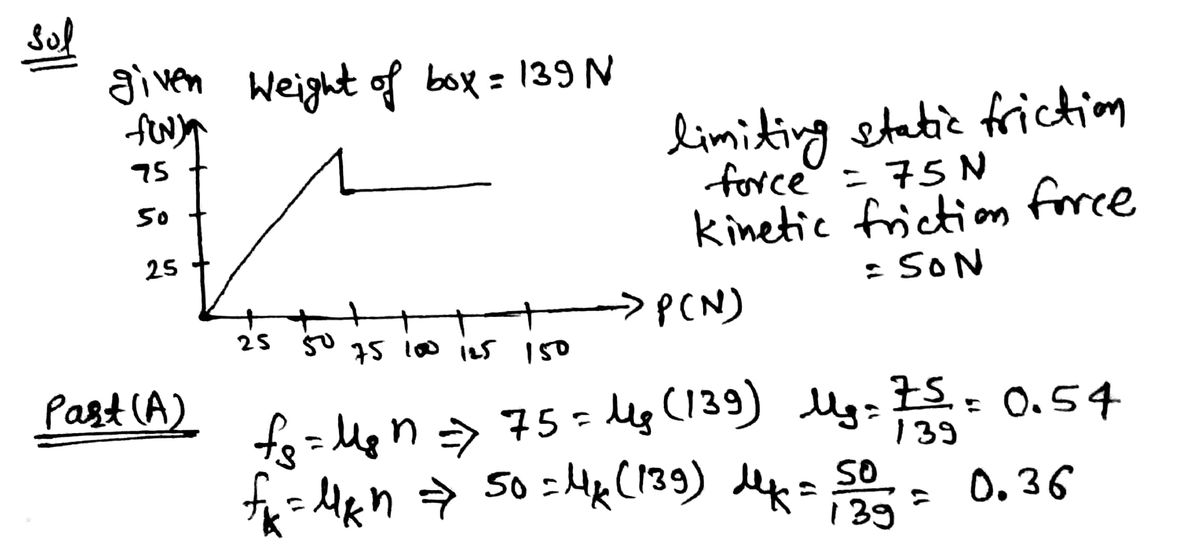In a laboratory experiment on friction, a 139-N block resting on a rough horizontal table is pulled by a horizontal wire. The pull gradually increases until the block begins to move and continues to increase thereafter. The figure (Figure 1) shows a graph of the friction force on this block as a function of the pull. Part B Why does the graph slant upward in the first part but then level out? Drag the terms on the left to the appropriate blanks on the right to complete the sentences. Reset Help fk = n From P = 0 to P = 75.0 N, the block is and the friction is fs = Hs P and has the value Figure < 1 of 1> moving since this prevents relative fs = P motion. This is why the graph has slope +1 for at rest this range of P. f(N) static From P = 75.0 N to P = 150.0 N, the block is 75.0 kinetic and the friction is 50.0 fk = kn and has the value 25.0 independent of P. This is why P (N) the graph is horizontal for this range of P. 25.0 50.0 75.0 100.0 125.0 150.0
In a laboratory experiment on friction, a 139-N block resting on a rough horizontal table is pulled by a horizontal wire. The pull gradually increases until the block begins to move and continues to increase thereafter. The figure (Figure 1) shows a graph of the friction force on this block as a function of the pull. Part B Why does the graph slant upward in the first part but then level out? Drag the terms on the left to the appropriate blanks on the right to complete the sentences. Reset Help fk = n From P = 0 to P = 75.0 N, the block is and the friction is fs = Hs P and has the value Figure < 1 of 1> moving since this prevents relative fs = P motion. This is why the graph has slope +1 for at rest this range of P. f(N) static From P = 75.0 N to P = 150.0 N, the block is 75.0 kinetic and the friction is 50.0 fk = kn and has the value 25.0 independent of P. This is why P (N) the graph is horizontal for this range of P. 25.0 50.0 75.0 100.0 125.0 150.0
College Physics
11th Edition
ISBN:9781305952300
Author:Raymond A. Serway, Chris Vuille
Publisher:Raymond A. Serway, Chris Vuille
Chapter1: Units, Trigonometry. And Vectors
Section: Chapter Questions
Problem 1CQ: Estimate the order of magnitude of the length, in meters, of each of the following; (a) a mouse, (b)...
Related questions
Topic Video
Question

Transcribed Image Text:Part A
Find the coefficients of static and kinetic friction between the block and the table.
Express your answers numerically separated by a comma.
ΑΣφ
?
ls lk =
Submit
Previous Answers Request Answer

Transcribed Image Text:I Review | Cc
In a laboratory experiment on friction, a 139-N block
resting on a rough horizontal table is pulled by a
horizontal wire. The pull gradually increases until the
block begins to move and continues to increase
thereafter. The figure (Figure 1) shows a graph of the
friction force on this block as a function of the pull.
Part B
Why does the graph slant upward in the first part but then level out?
Drag the terms on the left to the appropriate blanks on the right to complete the sentences.
Reset
Help
fk = n
From P = 0 to P = 75.0 N, the block is
and the friction is
fs = ls P
and has the value
moving
Figure
1 of 1
since this prevents relative
fs = P
motion. This is why the graph has slope +1 for
at rest
this range of P
f(N)
static
From P = 75.0N to P = 150.0 N, the block is
75.0
kinetic
and the friction is
50.0
fk = lkn
and has the value
25.0 E
independent of P. This is why
P (N)
the graph is horizontal for this range of P.
25.0 50.0 75.0 100.0 125.0 150.0
Expert Solution
Step 1

Trending now
This is a popular solution!
Step by step
Solved in 2 steps with 2 images

Knowledge Booster
Learn more about
Need a deep-dive on the concept behind this application? Look no further. Learn more about this topic, physics and related others by exploring similar questions and additional content below.Recommended textbooks for you

College Physics
Physics
ISBN:
9781305952300
Author:
Raymond A. Serway, Chris Vuille
Publisher:
Cengage Learning

University Physics (14th Edition)
Physics
ISBN:
9780133969290
Author:
Hugh D. Young, Roger A. Freedman
Publisher:
PEARSON

Introduction To Quantum Mechanics
Physics
ISBN:
9781107189638
Author:
Griffiths, David J., Schroeter, Darrell F.
Publisher:
Cambridge University Press

College Physics
Physics
ISBN:
9781305952300
Author:
Raymond A. Serway, Chris Vuille
Publisher:
Cengage Learning

University Physics (14th Edition)
Physics
ISBN:
9780133969290
Author:
Hugh D. Young, Roger A. Freedman
Publisher:
PEARSON

Introduction To Quantum Mechanics
Physics
ISBN:
9781107189638
Author:
Griffiths, David J., Schroeter, Darrell F.
Publisher:
Cambridge University Press

Physics for Scientists and Engineers
Physics
ISBN:
9781337553278
Author:
Raymond A. Serway, John W. Jewett
Publisher:
Cengage Learning

Lecture- Tutorials for Introductory Astronomy
Physics
ISBN:
9780321820464
Author:
Edward E. Prather, Tim P. Slater, Jeff P. Adams, Gina Brissenden
Publisher:
Addison-Wesley

College Physics: A Strategic Approach (4th Editio…
Physics
ISBN:
9780134609034
Author:
Randall D. Knight (Professor Emeritus), Brian Jones, Stuart Field
Publisher:
PEARSON